Vocal Matching in Animals
By Kendra Sewall
Learning the calls of group members and mates reliably signals social bonds
Learning the calls of group members and mates reliably signals social bonds

DOI: 10.1511/2012.97.306
We can often tell the country or region someone is from simply by hearing them speak. We do this, usually unconsciously, using cues such as speech pattern and vocabulary, which characterize regional dialects.

Cathy & Gordon ILLG
We can also frequently discover clues about someone’s social identity based on hearing them speak: People from different socioeconomic classes or age groups may use different inflections or intonations, even if they have the same regional dialect. In the movie Good Will Hunting, for example, characters from universities in Boston use different accents than do working-class characters from South Boston. The entire cast had to adopt a regional accent, but the actors imitated subtly different versions of that accent that were appropriate for the group their characters represented.
The phenomenon in which individuals from the same geographic area or social group share vocal characteristics is not unique to humans. Such shared vocal characteristics also occur in animal species that are capable of vocal learning. Vocal learning is defined as the production of a vocalization based on auditory input. It is a uncommon trait in the animal world, documented only in birds, cetaceans, bats, elephants and some species of primates. Although most animals probably do not need social experience to produce vocalizations that are species-typical, a handful of species are believed to learn to produce the vocal signals they make. Many of the species that are capable of learned vocal production also engage in vocal matching—imitating companions to generate vocalizations with similar acoustic structures. The occurrence of vocal matching across diverse species suggests that this relatively rare trait may play an important social function in the animal world. Like the aspects of human speech that point to social class and region of origin, shared features of animal communication signals have the potential to reflect aspects of individuals’ social background, because matched vocalizations in animals can be specific to different species, subspecies, populations, social groups, bonded pairs or families.

Francois Gohier/Photo Researchers
Orca whales (Orcinus orca) are one species capable of learning matched vocalizations. These whales hunt in stable groups, called pods. Research by Volker Deecke of the University of St. Andrews in Scotland and John Ford and colleagues at the University of British Columbia demonstrated that all of the pods in a given geographic region, which are genetically related to one another and are termed clans, produce a set of matched vocalizations. The shared features of these vocalizations result in a vocal dialect that is analogous to a human accent, reflecting the animals’ lineage and group membership. However, the vocalizations of pod mates share even more characteristics than do the dialects of clan members, making it possible for researchers to determine which particular social group a whale belongs to as well as its region of origin.
This example illustrates that shared vocalizations in animals clearly have the potential to reflect an individual’s social identity. However, we don’t expect animals to pay attention or respond to matched vocalizations unless doing so improves their survival and reproduction (which evolutionary biologists refer to as fitness). That is, in contrast to considering the complex social factors that influence patterns of language similarity in humans, studying vocal matching in animals first requires evaluating how the behavior affects measures related to individuals’ fitness, because traits in animals are shaped by natural and sexual selection.
Why do diverse animal species match companions’ vocalizations? Most species that engage in vocal matching do so specifically for a category of vocalizations referred to as contact calls. Vocalizing animals often use calls with particular sounds and structures in different circumstances (see sidebar, below). Many people are familiar with the angry chatter alarm call a squirrel makes when it detects a predator, or the aggressive bark of a male sea lion as it vies for space on the piers in San Francisco. Contact calls are a particular category of calls that animals produce to establish and maintain contact with companions while moving through their habitat or reuniting after separation.
Many animals produce contact calls, but the species that match contact calls with companions are almost all highly social. They may cooperate to find or defend food, raise young or avoid predators. Reviewing many animal studies yields the observation that diverse species with similar social dynamics converge on this specific category of calls that mediate social interactions. This finding is an important first clue that vocal matching may have a real fitness benefit. Common patterns of vocal behavior, ecology and sociality suggest that the ability to learn and match calls is an adaptive trait selected for by a particular set of environmental conditions. Further, the finding that vocal matching of contact calls often occurs among members of social groups that work together, or among members of mated pairs that rear young together, corroborates the idea that vocal matching specifically facilitates cooperative, mutually beneficial interactions.
The association between vocal matching and cooperation may seem intuitive because we (that is, humans) mimic other people’s accents and speech patterns. This vocal accommodation, as it is termed in the linguistics literature, is thought both to gain the trust of a listener and to improve the listener’s understanding of what is being said, thereby reflecting cooperative and affiliative intentions. But what evidence is there that individual animals actually increase their survival or reproductive success by imitating or responding to calls matched with mates, group members or others in their population?
There is probably one nearly universal benefit to imitating the calls of companions, which is that matched calls are more easily detected by listeners. Evidence from studies of several species suggests that animals’ auditory processing systems are sensitized to signals similar to those that an individual produces. Several researchers have argued that selective sensitivity ensures that listeners will detect and pay attention to matched vocalizations. Thus, matching calls may ensure that companions can hear one another or gain the attention of an intended listener. This might be analogous to hearing one’s name called in a noisy crowd; our sensory system picks up this important information despite background noise.
Some specific evidence that call matching improves signal detection comes from behavioral studies of spectacled parrotlets (Forpus conspicillatus). Spectacled parrotlets are small South American parrots that live in groups of 10 to 25 individuals, many of them bonded pairs or family members. Ralf Wanker and his colleagues at Universität Hamburg, Germany, found that each parrotlet produces a unique contact call, its signature call, but it also produces a mimicked version of the signature call of each family member when interacting with that specific bird. Playback studies by the authors show that birds respond more strongly to the imitations of their own signature call than to other calls, leading the biologists to conclude that imitated calls draw the attention of a targeted receiver. Similarly, budgerigars (Melopsittacus undulatus), also known as the common pet parakeet or budgie, produce signature calls and also sometimes mimic the calls of their mates and flock members. A neurobiological study in budgies, by Steven E. Brauth and his colleagues at the University of Maryland, found different patterns of brain activity in response to matched contact calls than in response to unmatched calls. Such differential neural responses suggest that matched calls are processed differently in the brain and support the hypothesis that individuals are sensitized to calls like their own.
Evidence that matched signals are more easily detected by listeners supports the idea that vocal matching could benefit those animals—called signalers—that imitate their companions’ calls. But the benefits of call production alone do not explain its common occurrence across vocal learning species. For matched calls to persist they must provide benefits to the individuals that listen to and then respond to the calls—known as receivers—as well. If imitation exploits the sensory sensitivity of receivers and permits signalers to manipulate receivers, then we can expect that individuals responding to matched calls will have decreased fitness and, over many generations, receivers will be selected to ignore matched calls. The persistence of vocal matching across species capable of vocal learning, and the association of vocal matching with affiliation and cooperation, lead us to infer that, instead, there must be fitness benefits for both signalers and receivers.
Call matching is most frequently described in mated pairs of animals. One fitness benefit that call matching may offer prospective pair members is the acceptance of a mate and thus an opportunity to breed. This hypothesis is based on reports that males of several species, including pygmy marmosets (Callithrix pygmaea), African elephants (Loxodonta africana) and several birds, change their calls to imitate females, apparently as part of the bonding process. For example, Arla G. Hile and colleagues at the University of California, Irvine, have found that male budgerigars change their calls to imitate a female over a period of several weeks during pair bonding, and they maintain pair-specific matched calls through the breeding season. In cases like these, males (the signalers) benefit from matching because they gain the acceptance of a mate; scientists hypothesize that females (the receivers) benefit because matching is indicative of a commitment to the pair bond.
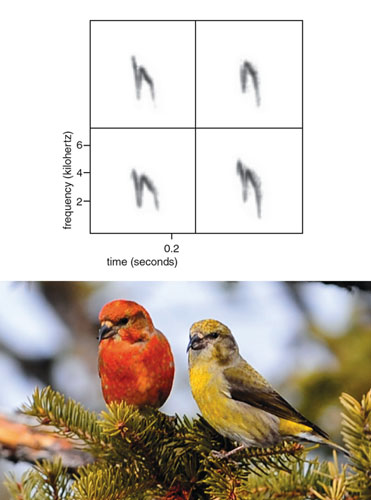
Photo at bottom by Christine Pentecost.
Spectrograms courtesy of the author.
Males of several vocal-matching species imitate females to generate pair-specific calls, but females of some species also learn new calls, with the result that both members of a pair slowly converge on a novel call that is distinct from their original calls. For example, a 2009 study of mine demonstrated that male and female red crossbills (Loxia curvirostra) in the North American range change their calls to converge on a new, shared pair-specific call (see Figure 3). In cases where both pair members arrive at a new call structure, the process of convergence may reflect a mutual investment in the social bond, rather than the effort of one individual to attract another.
Regardless of how they come about, matched calls in mated pairs not only reflect a social bond but may also help coordinate parental care of young, thus increasing reproductive success by increasing the survival rates of offspring. One clue that matched calls may improve parental care is that call matching in pairs is often associated with biparental care.
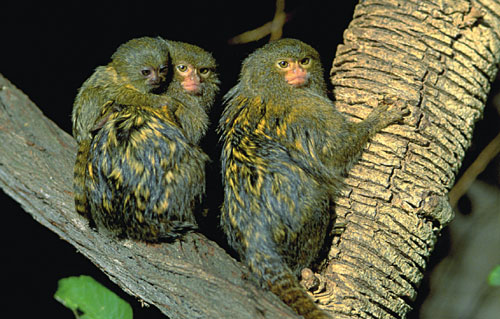
Gregory G. Dimijian, M.D./Photo Researchers
A classic example of matched calls in mated pairs, described by Paul Mundinger of Queens College in New York, is that male goldfinches (Carduelis species), like many other temperate zone songbirds, feed their mates while they are incubating eggs and later feed the nestlings. Males produce contact calls that are matched to the calls of their mates when returning to the nest with food, and females briefly come off the nest to be fed. In a study by Mundinger in which female goldfinches were played previously recorded calls both from neighboring males and from their mates, the females only approached the speaker and solicited food in response to their mates’ calls. We don’t know whether pairs that produce more similar calls have better reproductive success, but the pattern of behavior implicates matched calls in coordinating parental care of young and may thus improve the parents’ fitness.
In some animals, the young also learn calls like those of their parents, generating family-specific calls, which can help parents and young reunite when adults return from foraging trips. Parents are thought to benefit from vocal matching within families because it increases their reproductive success, and their offspring could clearly benefit because when their parents find them, they receive food, and thus their likelihood of survival is increased. For example, as Ian Rowley of Australia’s Commonwealth Scientific and Industrial Research Organisation found in 1980, in galahs (Eolophus roseicapilla), a cockatoo species native to Australia, pairs converge on matched calls, and chicks learn calls just like those of their parents, generating matched family-specific calls. These family-specific calls are important for reuniting parents with their offspring after foraging trips. Galahs roost in large colonies and nest in cavities, so parents can have trouble identifying the correct nest entrance. Chicks call back to their parents when they hear them approach the roost, helping direct the parents and stimulate feeding. When young birds fledge and move throughout the roosting area while the parents are foraging, matched calls become even more important, helping families reunite in a noisy, crowded social environment.
Vocal matching in the context of pair bonding may help individuals gain access to mates or improve parental care of young and thus, presumably, increase their reproductive success. Biologists have found evidence that matched calls among members of a social group provide different benefits—group-specific calls often facilitate the cooperative defense of resources, such as food, from competing groups, thereby increasing access to those resources.
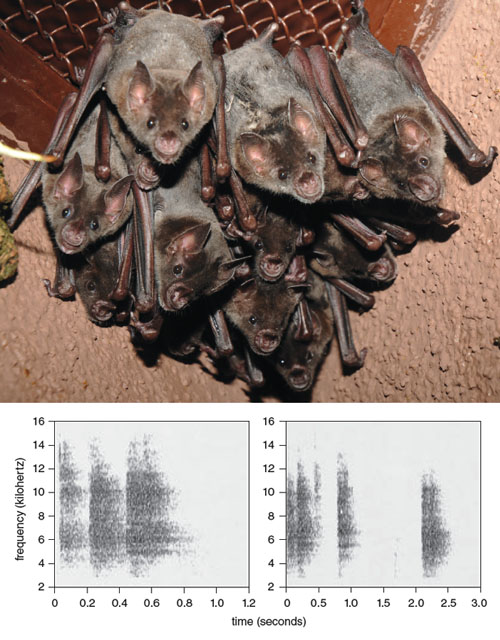
Photograph by Milan Korínek. Spectrograms from Janette W. Boughman and Gerald S. Wilkinson, 1998. Reprinted with permission from Elsevier.
Both producing a call matched with group members (as a signaler) and responding to companions’ matched calls (as a receiver) may benefit individuals in several ways. First, matched calls present an efficient way to identify group members, particularly in large groups when not all individuals are familiar with one another. Because matched calls emerge through the process of imitative learning, which often requires sustained social contact, they reflect the social experiences of the signaler and effectively encode aspects of that individual’s social background. Thus, matched calls might provide listeners with information about individuals within their larger social network with whom they are less familiar, permitting listeners to quickly determine whether another animal has experience with, and therefore belongs to, their social group. This idea is known as the badge, or password, hypothesis. A case in which group-specific calls may serve as passwords was studied by Janette Boughman and Gerald Wilkinson, of the University of Maryland, College Park. Female greater spear-nosed bats (Phyllostomus hastatus) form roosts together in very large aggregations; all members of a single roost produce matched social calls during nighttime foraging excursions. Experiments in which new roosts were formed showed that female bats converged on new matched calls with their new companions over a period of months. Subsequent observational and playback studies have demonstrated that female bats use these matched calls to recruit other members of their roost when they find a rich food resource and that the members of a roost then collectively defend the food source from other bats. Taken together, these studies suggest that matched calls serve as passwords for group membership and help coordinate cooperative foraging in a noisy, fast-paced social environment by facilitating the rapid discrimination of group members from outsiders and permitting bats who are guarding a food source to quickly identify roost mates.
The example of greater spear-nosed bats illustrates at least one other related but distinct benefit of matched calls within social groups—their capacity to reflect group identity to non–group members. That is, matched calls may not only facilitate the rapid identification of companions, but they may also inform outsiders of the size and competitive ability of a defending social group.
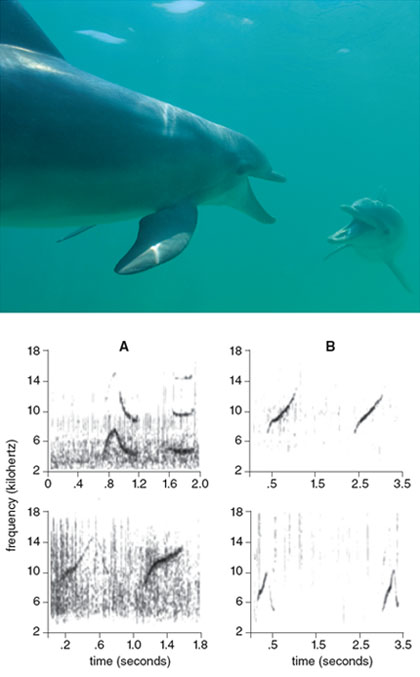
Photo at top by Rene Frederick.
Spectrograms from Vincent M. Janik, 2000. Reprinted with permission from AAAS.
A review article by Peter L. Tyack of the University of Saint Andrews includes the example of bottlenose dolphins (Tursiops species), which provide an opportunity to assess how calls are employed in communication with familiar group members. Male dolphins form alliances with one or two other individuals upon reaching maturity. These small groups spend up to 80 percent of their time together, often until one member of the alliance dies. Members of a dolphin alliance slowly converge on a shared whistle, but they also maintain signature whistles. Thus, unlike species such as goldfinches and greater spear-nosed bats, in which each individual produces a single contact call variant, dolphins have at least two contact signals—a signature whistle that reflects individual identity and an alliance-specific whistle that is a badge of group membership. To understand how dolphins use their two whistle types, researchers studied males of a captive alliance that were permitted to move freely between two pools. They found that males used their signature whistles, not their alliance-specific whistles, when they were separated from their group. Dolphins, and probably other animals, use signals or signal features that reflect individual identity when communicating with familiar companions and, biologists hypothesize, use matched calls that reflect group identity in the presence of unfamiliar competitors.
Whether matched calls communicate group membership to companions or inform non–group members of the size and intent of the defending group, researchers have found evidence that producing and responding to matched calls provides fitness benefits to group members for at least two reasons: By producing the “correct” call, they gain access to resources, and by responding to matched group-specific calls, they can better protect resources from non–group members that might try to enter their territory or monopolize resources.
In addition to improving cooperative group dynamics and the coordination of parental care of young, matched calls at the level of populations, which are referred to as dialects, may help animals identify appropriate mates and companions. Although call dialects are relatively rare, they have been described in orca whales and sperm whales (Physeter macrocephalus), as reviewed by Tyack, as well as in bird species such as yellow-naped Amazon parrots (Amazona auropalliata) and red crossbills. In each of these species, there are several categorically distinct dialects, and individuals produce calls ascribed to a single dialect type (see below).
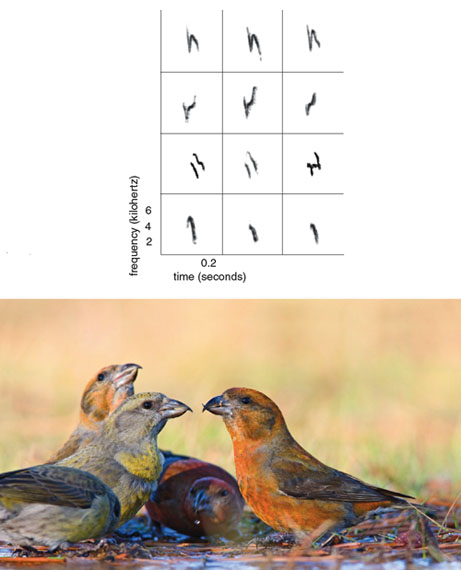
Photo at bottom by Ardea/Jim Zipp/Animals Animals
Spectrograms courtesy of the author.
As with group-specific matched calls, there is evidence that individuals of species with dialects generally adopt the calls of their new companions when they disperse to a different population. For example, Timothy Wright, now of New Mexico State University in Las Cruces, and his colleagues inferred from genetic studies that yellow-naped Amazon parrots disperse across dialect boundaries and learn the call structure of their adopted locale, concurrently adopting new roost-specific matched calls and new population-specific dialects. The authors have proposed that immigrants in this and other species learn the local dialect to gain access to roost sites and to be permitted on foraging trips during which they learn about and gain access to local foraging areas—resources important for their survival. In species such as parrots that often forage and roost in groups and cooperate in rearing young, individual receivers that choose foraging partners and mates that produce the local call dialect are thus assured that their companions are capable of finding food and selecting a safe roost site, so they too will benefit from access to those resources.
Although animals such as yellow-naped Amazon parrots learn new call dialects, a handful of species are unable or unwilling to learn different dialects in adulthood. When animals do not or cannot learn to produce or recognize one another’s vocalizations, their ability to coordinate social behaviors is constrained. The failure to learn new call dialects might limit communication between populations and thus limit their social and genetic intermixing.
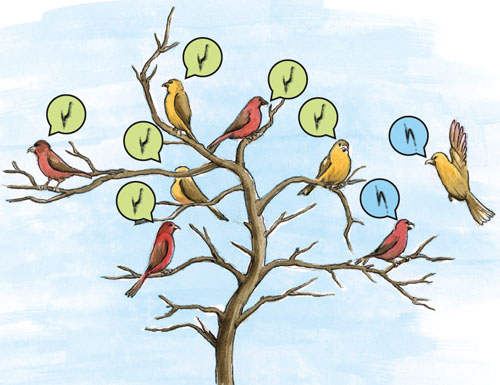
Illustration by Barbara Aulicino.
For example, Jeff Groth of the American Museum of Natural History in New York and Craig Benkman at the University of Wyoming found that call dialects were associated with different size classes, or “races,” of red crossbills. Crossbills of each size class have a distinctive bill size and shape that permits them to feed especially well on a particular type of conifer cone. Studies by Julie W. Smith and her colleagues at New Mexico State University found that crossbills benefit from flocking with birds that share their feeding preference, because companions share information about foraging success, increasing the feeding efficiency of each group member.
However, crossbills of different foraging specializations can be difficult to identify based on appearance alone, and birds of different size classes and foraging specializations can be found in mixed forests. The distinct call dialects that birds of each size class produce are the most conspicuous differences among these groups and have the potential to inform crossbills of other birds’ foraging specializations. Indeed, my research, in conjunction with work from the Benkman lab, demonstrates that crossbills learn their call dialects early in life, prior to fledging and dispersing into new populations, and they almost never change their call dialects upon reaching maturity. Thus, call dialects are reliable indicators of size class and feeding specialty. Because contact calls are central to group formation and cohesion, dialects not only reflect the foraging specialization of each individual but also permit assortment by size class and foraging preference. Collectively, call dialects impede communication and social bonding between birds of different size classes and are believed to be facilitating the ongoing speciation of red crossbills.
The cumulative evidence from studies considering animals with many different social systems suggests that vocal matching increases individuals’ survival and reproduction in three possible ways: by securing the acceptance of a mate or improving the coordination of parenting efforts, by securing and preserving access to shared resources, or by aiding in the selection of appropriate mates and companions. If we accept this evidence, we then have to ask what mechanisms ensure that vocal matching is a reliable indicator of social identity and cooperation. What prevents cheaters from taking advantage of the system and matching but not reciprocating as mates or group members? Identifying the mechanisms that ensure that individuals don’t simply adopt the calls of multiple mates, foraging groups or populations to reap the benefits of call matching without reciprocation requires examining the learning process that underlies vocal matching. (For more on the different types of calls animals use, see the sidebar above.)
One reason that the process of matching calls with companions could reliably reflect a signaler’s investment in a social bond or a commitment to cooperate is that the process of learning new vocalizations generally carries some cost, as explained by William A. Searcy of the University of Miami in Florida and Stephen Nowicki of Duke University, in an article for the March–April 2008 issue of American Scientist. In the case of call learning, there is evidence that the learning process requires time and effort, which could indicate to companions that an individual is invested in and committed to a cooperative relationship. Further, vocal learning can require specialized brain circuitry, and the brain regions specialized for vocal learning can demand energetic resources, particularly during a vulnerable period of development when extra growth is especially costly. Thus the very capacity to learn vocalizations and engage in vocal matching reflects an investment. However, the process of learning new matched calls probably forges the strongest link between vocal matching and affiliation.
Species from chickadees (Poecile species) to pygmy marmosets require several weeks to settle on a matched vocalization with new mates or group members. In some cases, social bonds have been shown to form during the period of vocal matching, linking investment in the matching process with social bonding. For example, male European siskins (Carduelis spinus) housed together in captivity modify their contact calls to match one another. The process of vocal change requires several weeks, and the birds that match the calls of their companions most quickly also engage in affiliative behaviors more quickly and at a higher rate than birds that are slower to engage in vocal matching.
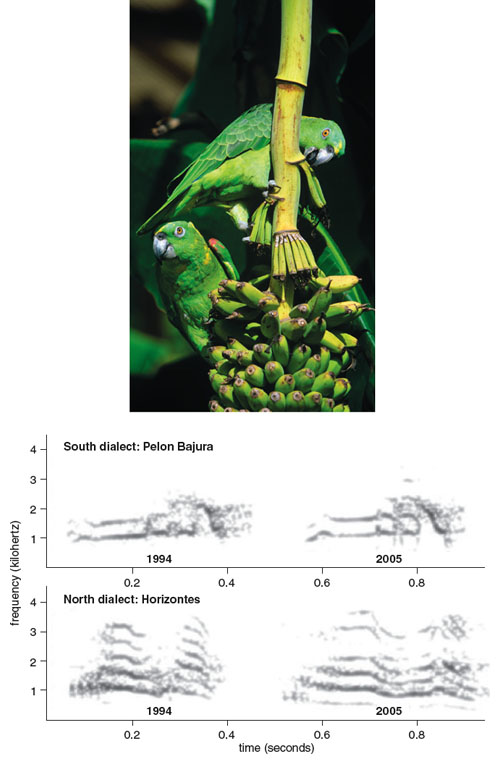
Photo at top by Juergen & Christine Sohns/Animals Animals
Spectrograms from Timothy F. Wright et al, 2008. Reprinted with permission from Elsevier.
The temporal correlation between learning and affiliation may actually occur because the process of learning can be improved by, or may even require, social interaction. In some species, vocal learning can be reinforced by positive feedback, so better or faster matching should result from positive social interactions with the mate or companions an individual is learning to imitate. Specific evidence that vocal matching is improved or guided by positive feedback comes from studies of male budgerigars. Kazuchika Manabe of Nihon University and Robert J. Dooling of the University of Maryland used the experimental approach known as operant conditioning, in which animals are rewarded for displaying particular behaviors, to train male budgies to imitate a call they hear for a food reward. Female budgerigars prefer males that produce calls more like their own, so it is possible that positive feedback from females could similarly direct and reinforce vocal matching. Cases in which time and social experience are associated with the rate or degree of vocal matching illustrate that the learning process itself can reliably link vocal matching with social bonding and support a direct connection between affiliation and investment in vocal change.
Collectively, the time, the effort and particularly the cognitive machinery that animals must invest in learning new vocalizations could ensure that vocal matching honestly reflects an affiliative bond. These requisite resources may explain the association of vocal matching and affiliation both across levels of social organization and across the diverse species capable of vocal learning.
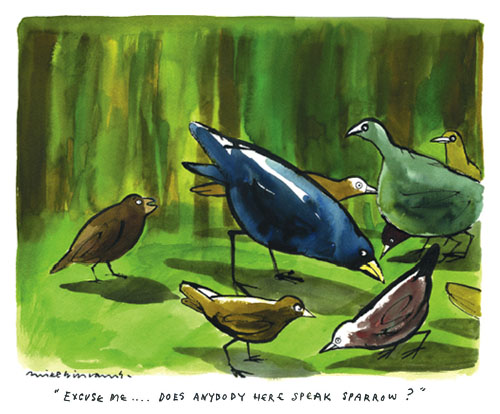
As my work and the other studies considered here show, call matching occurs in many of the animals capable of vocal learning, and there is evidence that it confers fitness benefits to signalers and receivers by increasing individuals’ reproductive success and survival. Specifically, call matching may help individuals gain access to a mate or coordinate parental care of offspring; secure and retain access to resources; or identify appropriate mates and companions. Though the specific fitness benefits that drive vocal matching vary across levels of social organization, the learning process underlying it may explain the association between vocal matching and affiliation among vocal learners. Studies that tease out direct links between vocal matching and fitness are ongoing, but thus far it seems that species who learn to produce matched calls are better able to gain companions’ attention and maintain contact with them in complex, changeable and often noisy social environments—and that this improved communication contributes to increased fitness.
Click "American Scientist" to access home page
American Scientist Comments and Discussion
To discuss our articles or comment on them, please share them and tag American Scientist on social media platforms. Here are links to our profiles on Twitter, Facebook, and LinkedIn.
If we re-share your post, we will moderate comments/discussion following our comments policy.